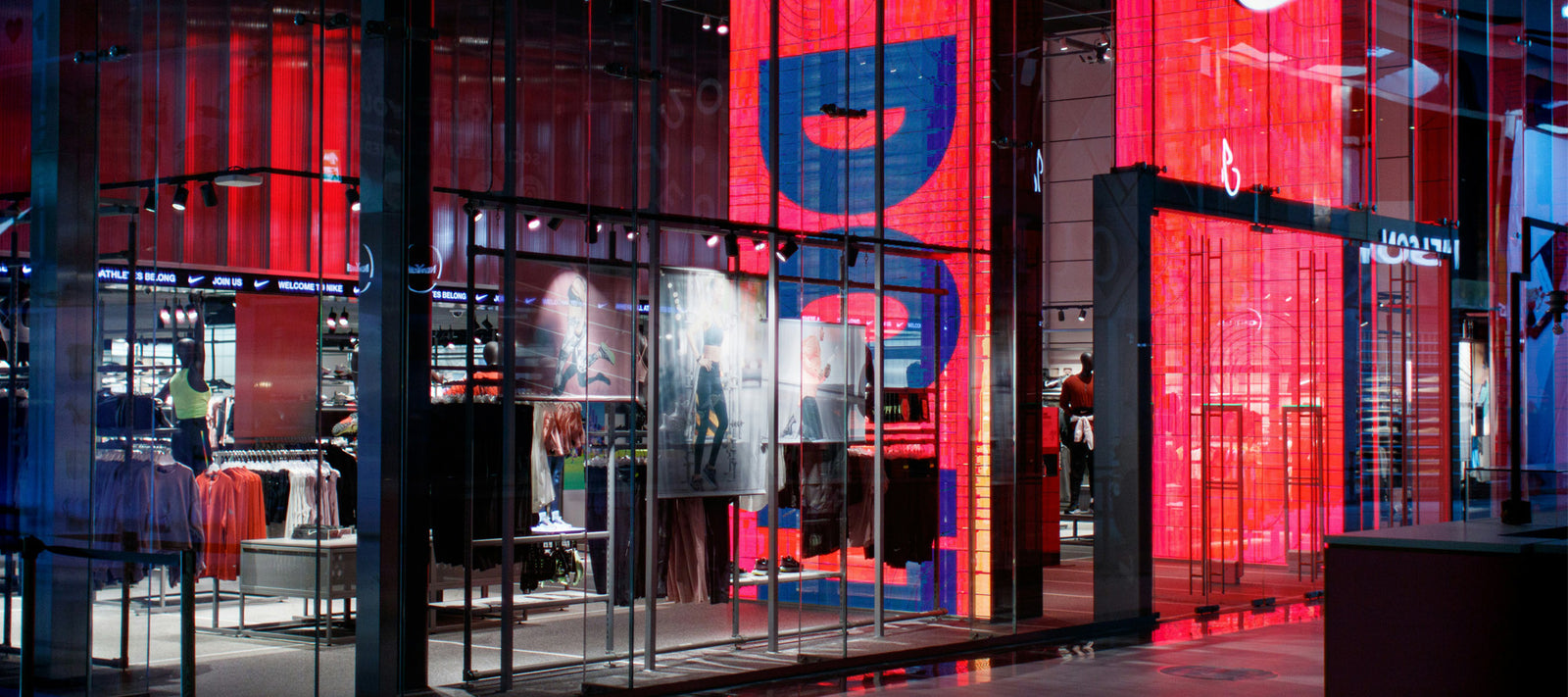In today's competitive retail landscape, success hinges on more than just offering quality products. Consumers crave unique and immersive experiences that engage their senses and cater to their evolving needs. Enter the innovative use of technology in retail design, where virtual mirrors and augmented reality (AR) are revolutionising the shopping experience. In this blog post, we'll explore how these cutting-edge technologies are reshaping retail spaces, enhancing customer engagement, and driving sales.
The Intersection of Technology and Design in Retail
Retail design has evolved significantly in recent years, with technology playing an increasingly central role in shaping the physical environment. From interactive displays to seamless checkout experiences, retailers are harnessing the power of technology to create immersive and personalised journeys for customers. Among the most transformative innovations are virtual mirrors and augmented reality, which blur the lines between the digital and physical worlds, offering shoppers a glimpse into the future of retail.
Virtual Mirrors: Redefining the Fitting Room Experience
1. Enhancing the Fitting Room Experience:
Traditional fitting rooms can be a source of frustration for shoppers, leading to long queues and subpar experiences. Virtual mirrors offer a solution by allowing customers to try on clothing virtually, eliminating the need to physically undress and try on multiple items.
2. Personalisation and Customisation:
Virtual mirrors can be tailored to individual preferences, allowing shoppers to experiment with different styles, colours, and sizes at the touch of a button. This level of personalisation enhances the shopping experience and increases the likelihood of a purchase.
3. Seamless Integration with E-Commerce:
Virtual mirrors bridge the gap between online and offline shopping, enabling customers to seamlessly transition from browsing online to trying on items in-store. This integration creates a cohesive shopping journey and encourages omnichannel engagement.
Augmented Reality (AR): Bringing Products to Life
1. Interactive Product Visualisation:
AR technology allows retailers to create interactive experiences where customers can visualise products in their real-world environment. Whether trying out furniture in their living room or previewing makeup shades on their face, AR enhances the decision-making process and reduces purchase hesitation.
2. Virtual Try-On Experiences:
AR-powered virtual try-on experiences are revolutionising the beauty and fashion industries. Customers can virtually try on makeup, glasses, jewellery, and even clothing, gaining confidence in their purchase decisions without needing to physically try on the items.
3. Engaging Storytelling:
AR enables retailers to tell captivating stories about their products, immersing customers in brand narratives and creating memorable experiences. Whether through interactive displays or AR-enabled packaging, this technology fosters emotional connections and brand loyalty.
Success Stories in Retail Design Innovation
1. Sephora's Virtual Artist:
Sephora's Virtual Artist app allows customers to try on makeup virtually using AR technology. By offering a seamless virtual try-on experience, Sephora has increased customer engagement and sales both online and in-store.
2. IKEA Place:
IKEA's augmented reality app, IKEA Place, allows customers to visualise furniture in their own homes before making a purchase. This innovative use of AR has transformed the furniture shopping experience, reducing returns and enhancing customer satisfaction.
3. L'Oréal's Makeup Genius:
L'Oréal's Makeup Genius app uses AR technology to enable customers to virtually try on makeup products in real-time. By offering a fun and interactive way to explore cosmetics, L'Oréal has strengthened its brand presence and increased customer engagement.
The Future of Retail Design: Embracing Technology and Innovation
1. Seamless Integration of Online and Offline Channels:
As technology continues to advance, retailers will need to seamlessly integrate online and offline channels to create cohesive and personalised shopping experiences for customers.
2. Hyper-Personalisation and Data Analytics:
The future of retail design lies in hyper-personalisation and data-driven insights. By leveraging customer data and predictive analytics, retailers can anticipate customer needs and preferences, offering tailored experiences that drive loyalty and sales.
3. Emerging Technologies:
From virtual reality (VR) to artificial intelligence (AI), emerging technologies will continue to shape the future of retail design. By embracing innovation and staying ahead of the curve, retailers can stay competitive in an increasingly digital marketplace.
Shaping the Future of Retail
The innovative use of technology in retail design is transforming the way we shop, blurring the lines between the physical and digital worlds. Virtual mirrors and augmented reality are just the beginning, offering a glimpse into the future of retail where immersive experiences and hyper-personalisation reign supreme. As retailers continue to embrace technology and innovation, the possibilities for creating memorable and engaging shopping experiences are endless. By staying at the forefront of retail design trends, businesses can not only meet but exceed customer expectations, driving growth and success in an ever-evolving industry.
The Intersection of Technology and Design in Retail
Retail design has evolved significantly in recent years, with technology playing an increasingly central role in shaping the physical environment. From interactive displays to seamless checkout experiences, retailers are harnessing the power of technology to create immersive and personalised journeys for customers. Among the most transformative innovations are virtual mirrors and augmented reality, which blur the lines between the digital and physical worlds, offering shoppers a glimpse into the future of retail.
Virtual Mirrors: Redefining the Fitting Room Experience
1. Enhancing the Fitting Room Experience:
Traditional fitting rooms can be a source of frustration for shoppers, leading to long queues and subpar experiences. Virtual mirrors offer a solution by allowing customers to try on clothing virtually, eliminating the need to physically undress and try on multiple items.
2. Personalisation and Customisation:
Virtual mirrors can be tailored to individual preferences, allowing shoppers to experiment with different styles, colours, and sizes at the touch of a button. This level of personalisation enhances the shopping experience and increases the likelihood of a purchase.
3. Seamless Integration with E-Commerce:
Virtual mirrors bridge the gap between online and offline shopping, enabling customers to seamlessly transition from browsing online to trying on items in-store. This integration creates a cohesive shopping journey and encourages omnichannel engagement.
Augmented Reality (AR): Bringing Products to Life
1. Interactive Product Visualisation:
AR technology allows retailers to create interactive experiences where customers can visualise products in their real-world environment. Whether trying out furniture in their living room or previewing makeup shades on their face, AR enhances the decision-making process and reduces purchase hesitation.
2. Virtual Try-On Experiences:
AR-powered virtual try-on experiences are revolutionising the beauty and fashion industries. Customers can virtually try on makeup, glasses, jewellery, and even clothing, gaining confidence in their purchase decisions without needing to physically try on the items.
3. Engaging Storytelling:
AR enables retailers to tell captivating stories about their products, immersing customers in brand narratives and creating memorable experiences. Whether through interactive displays or AR-enabled packaging, this technology fosters emotional connections and brand loyalty.
Success Stories in Retail Design Innovation
1. Sephora's Virtual Artist:
Sephora's Virtual Artist app allows customers to try on makeup virtually using AR technology. By offering a seamless virtual try-on experience, Sephora has increased customer engagement and sales both online and in-store.
2. IKEA Place:
IKEA's augmented reality app, IKEA Place, allows customers to visualise furniture in their own homes before making a purchase. This innovative use of AR has transformed the furniture shopping experience, reducing returns and enhancing customer satisfaction.
3. L'Oréal's Makeup Genius:
L'Oréal's Makeup Genius app uses AR technology to enable customers to virtually try on makeup products in real-time. By offering a fun and interactive way to explore cosmetics, L'Oréal has strengthened its brand presence and increased customer engagement.
The Future of Retail Design: Embracing Technology and Innovation
1. Seamless Integration of Online and Offline Channels:
As technology continues to advance, retailers will need to seamlessly integrate online and offline channels to create cohesive and personalised shopping experiences for customers.
2. Hyper-Personalisation and Data Analytics:
The future of retail design lies in hyper-personalisation and data-driven insights. By leveraging customer data and predictive analytics, retailers can anticipate customer needs and preferences, offering tailored experiences that drive loyalty and sales.
3. Emerging Technologies:
From virtual reality (VR) to artificial intelligence (AI), emerging technologies will continue to shape the future of retail design. By embracing innovation and staying ahead of the curve, retailers can stay competitive in an increasingly digital marketplace.
Shaping the Future of Retail
The innovative use of technology in retail design is transforming the way we shop, blurring the lines between the physical and digital worlds. Virtual mirrors and augmented reality are just the beginning, offering a glimpse into the future of retail where immersive experiences and hyper-personalisation reign supreme. As retailers continue to embrace technology and innovation, the possibilities for creating memorable and engaging shopping experiences are endless. By staying at the forefront of retail design trends, businesses can not only meet but exceed customer expectations, driving growth and success in an ever-evolving industry.






